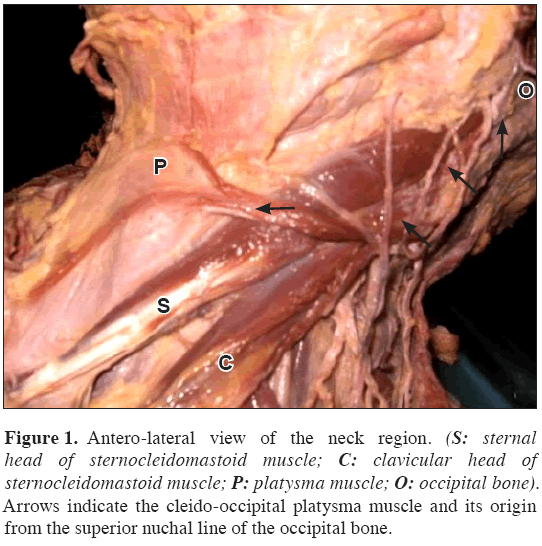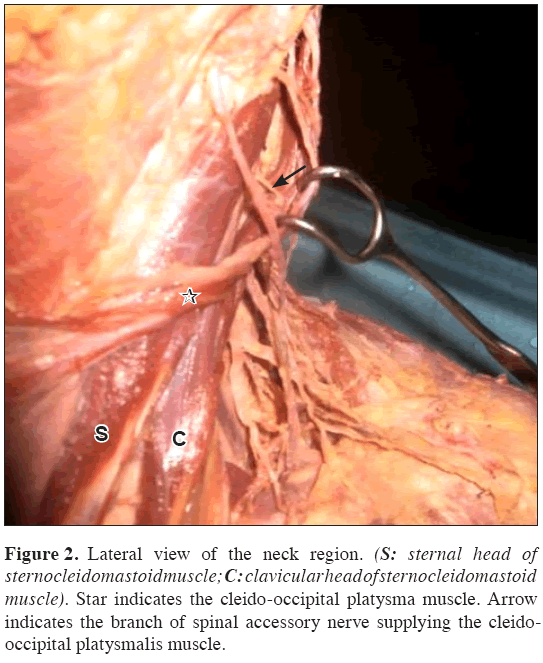Cleido-occipital platysma muscle: a rare variant of sternocleidomastoid muscle
Madhan Kumar SJ1, Shanmuga Sundaram M1, Aleyamma Fenn1, Soubhagya R Nayak2*, Ashwin Krishnamurthy2
1Department of Anatomy, P.S.G. Institute of Medical Sciences and Research, Peelamedu, Coimbatore, Tamilnadu, India.
2Department of Anatomy, Centre for Basic Sciences, Kasturba Medical College, Mangalore, Karnataka , India.
- *Corresponding Author:
- Soubhagya R NAYAK, MSc
Lecturer, Department of Anatomy, Centre for Basic Sciences, Kasturba Medical College, Bejai, Mangalore, Karnataka, 575004, India.
Tel: +91 824 2211746
Fax: +91 824 2421283
E-mail: ranjanbhatana@gmail.com
Date of Received: September 25th, 2008
Date of Accepted: January 11th, 2009
Published Online: January 17th, 2009
© IJAV. 2009; 2: 9–10.
[ft_below_content] =>Keywords
sternocleidomastoid muscle, cleido-occipital platysma muscle, mesenchymal cells, post-otic neural crest
Introduction
The sternocleidomastoid muscle (SCM) is essential for the majority of the head movements, and also considered as an accessory muscle of respiration [1]. It is one of the most complex muscles in the body, which acts as short and long range rotator, an upper cervical spine extensor, and a lateral flexor, as well as very important source of equilibrium [2]. In classical anatomical description, SCM has clavicular and sternal heads of origin, which is inserted into the lateral surface of the mastoid process of the temporal bone and to the lateral half of the superior nuchal line in the occipital bone [3]. Different variations of the SCM were reported with reference to its supernumerary heads by various authors [4,5,6]. The SCM may consist of two layers (superficial and deep layers) and five parts, out of these five parts the superficial layer consists of superficial sternomastoid, sterno-occipital, and cleido-occipital parts. Deep layer have sternomastoid and cleidomastoid parts [7].
Case Report
During routine dissection of 60-year-old female cadaver on the left head and neck region, we encountered a supernumerary muscle bundle 5.5 cm above the mid-clavicle, lying on the cleido-mastoid part of SCM. The muscle bundle was 1.8 cm wide close to its origin from the superior nuchal line of the occipital bone, while the bundle tapers obliquely downwards, and merged with the platysma (Figure 1). The muscle bundle received its nerve supply from the branches of the spinal accessory nerve (Figure 2). According to its origin, insertion and innervation features, the supernumerary muscle bundle was named cleido-occipital platysma muscle (COP).
Figure 1: Antero-lateral view of the neck region. (S: sternal head of sternocleidomastoid muscle; C: clavicular head of sternocleidomastoid muscle; P: platysma muscle; O: occipital bone). Arrows indicate the cleido-occipital platysma muscle and its origin from the superior nuchal line of the occipital bone.
Discussion
The present case discusses the possible embryological and genetic basis for the occurrence of this type of variation in the sternocleidomastoid muscle. A supernumerary cleido-occipital (Wood) muscle more (or) less separate from the SCM has been reported with a frequency of 33% [7]. SCM formed by five portions arranged in two layers as indicated by the comparative anatomical studies; however, Boaro and Fragoso reported the SCM to be formed by four portions [8].
Since, the COP situated superficially in the posterior triangle of the neck, it overlies a number of small arteries and nerves. It may therefore, compress on any of these structures. The trapezius and SCM arises from a common pre-muscle mass in the occipital region just caudal to the last branchial arch. This myotome separates to the ventral part forming SCM and dorsal part forming trapezius [9]. The possible explanation for the occurrence of COP may be attributed to the differentiation of mesenchymal cells surrounding the myoblasts, giving rise to platysma muscle which fuses with the migrating occipital myotomes.
The muscle fibers for the SCM and trapezius are derived from (Hox D4+) somitic mesoderm, where these fibers are connected to skeletal elements only by post otic neural crest derived connective tissue, in contrast to the mesodermal skeletal structure. As Hox D4+ somites provides muscle cells to branchial neck muscles, these myoblasts appear to be subjugated to neural crest derived muscle connective tissue, which do not attach directly on to skeletal region as done by the mesodermal muscle [9]. This fact best suits to the COP, where some fibers of this muscle were merged with the connective tissue surrounding the platysma muscle and not with the skeletal elements.
The observations made here supplement our knowledge of variations in the antero-lateral neck region, which may be quite useful for the surgeons operating in this region.
References
- Gardetto A, Dabernig J, Rainer C, Piegger J, Piza-Katzer H, Fritsch H. Does a superficial musculoaponeurotic system exist in the face and neck? An anatomical study by the tissue plastination technique. Plast. Reconstr. Surg. 2003; 111: 664–672.
- Sarikcioglu L, Donmez BO, Ozkan O. Cleidooccipitalmuscle: An anomalous muscle in the neck region. Folia Morphol (Warsz). 2001; 60: 347–349.
- Gray H. Anatomy of the human body. 30th Ed., Philadelphia, Lea & Febiger. 1985; 456.
- Marecki B, Lewandowski J, Jakubowicz M. Anthropomorphology of sternocleidomastoid muscle. Gegenbaurs Morphol. Jahrb. 1989; 135: 491–503.
- Miyauchi R, Kato S. A rare anomalous muscle of the neck: a case with the Supernumerärer Bauch des Musculus sternocleidomastoideus (Gruber, 1885). Okajimas Folia Anat. Jpn. 1983; 60: 187–193.
- Nayak SR, Krishnamurthy A, Sj MK, Pai MM, Prabhu LV, Jetti R. A rare case of bilateral sternocleidomastoid muscle variation. Morphologie. 2006; 90: 203–204.
- Bergman RA, Thompson SA, Afifi AK, Saadeh FA. Compendium of human anatomic variation. Baltimore, Urban & Schwarzenberg. 1988; 32–33.
- Boaro SN, Fragoso Neto RA. Topographic variation of the sternocleidomastoid muscle in a just been born children. Int. J. Morphol. 2003; 21: 261–264.
- Matsuoka T, Ahlberg PE, Kessaris N, Iannarelli P, Dennehy U, Richardson WD, McMahon AP, Koentges G. Neural crest origins of the neck and shoulder. Nature. 2005; 436: 347–355.
Madhan Kumar SJ1, Shanmuga Sundaram M1, Aleyamma Fenn1, Soubhagya R Nayak2*, Ashwin Krishnamurthy2
1Department of Anatomy, P.S.G. Institute of Medical Sciences and Research, Peelamedu, Coimbatore, Tamilnadu, India.
2Department of Anatomy, Centre for Basic Sciences, Kasturba Medical College, Mangalore, Karnataka , India.
- *Corresponding Author:
- Soubhagya R NAYAK, MSc
Lecturer, Department of Anatomy, Centre for Basic Sciences, Kasturba Medical College, Bejai, Mangalore, Karnataka, 575004, India.
Tel: +91 824 2211746
Fax: +91 824 2421283
E-mail: ranjanbhatana@gmail.com
Date of Received: September 25th, 2008
Date of Accepted: January 11th, 2009
Published Online: January 17th, 2009
© IJAV. 2009; 2: 9–10.
Abstract
Additional and abnormal muscles are not an uncommon in the head and neck region. A supernumerary muscle bundle from the cleido-mastoid part of sternocleidomastoid muscle was encountered during routine dissection of the head and neck region of a 60-year-old female cadaver. The supernumerary muscle bundle was merging with the fibers of platysma muscle. The description of such a muscle in the modern literature is vague and we named the abnormal muscle bundle as cleido-occipital platysma muscle. The clinical and embryological significance of the variation is discussed
-Keywords
sternocleidomastoid muscle, cleido-occipital platysma muscle, mesenchymal cells, post-otic neural crest
Introduction
The sternocleidomastoid muscle (SCM) is essential for the majority of the head movements, and also considered as an accessory muscle of respiration [1]. It is one of the most complex muscles in the body, which acts as short and long range rotator, an upper cervical spine extensor, and a lateral flexor, as well as very important source of equilibrium [2]. In classical anatomical description, SCM has clavicular and sternal heads of origin, which is inserted into the lateral surface of the mastoid process of the temporal bone and to the lateral half of the superior nuchal line in the occipital bone [3]. Different variations of the SCM were reported with reference to its supernumerary heads by various authors [4,5,6]. The SCM may consist of two layers (superficial and deep layers) and five parts, out of these five parts the superficial layer consists of superficial sternomastoid, sterno-occipital, and cleido-occipital parts. Deep layer have sternomastoid and cleidomastoid parts [7].
Case Report
During routine dissection of 60-year-old female cadaver on the left head and neck region, we encountered a supernumerary muscle bundle 5.5 cm above the mid-clavicle, lying on the cleido-mastoid part of SCM. The muscle bundle was 1.8 cm wide close to its origin from the superior nuchal line of the occipital bone, while the bundle tapers obliquely downwards, and merged with the platysma (Figure 1). The muscle bundle received its nerve supply from the branches of the spinal accessory nerve (Figure 2). According to its origin, insertion and innervation features, the supernumerary muscle bundle was named cleido-occipital platysma muscle (COP).
Figure 1: Antero-lateral view of the neck region. (S: sternal head of sternocleidomastoid muscle; C: clavicular head of sternocleidomastoid muscle; P: platysma muscle; O: occipital bone). Arrows indicate the cleido-occipital platysma muscle and its origin from the superior nuchal line of the occipital bone.
Discussion
The present case discusses the possible embryological and genetic basis for the occurrence of this type of variation in the sternocleidomastoid muscle. A supernumerary cleido-occipital (Wood) muscle more (or) less separate from the SCM has been reported with a frequency of 33% [7]. SCM formed by five portions arranged in two layers as indicated by the comparative anatomical studies; however, Boaro and Fragoso reported the SCM to be formed by four portions [8].
Since, the COP situated superficially in the posterior triangle of the neck, it overlies a number of small arteries and nerves. It may therefore, compress on any of these structures. The trapezius and SCM arises from a common pre-muscle mass in the occipital region just caudal to the last branchial arch. This myotome separates to the ventral part forming SCM and dorsal part forming trapezius [9]. The possible explanation for the occurrence of COP may be attributed to the differentiation of mesenchymal cells surrounding the myoblasts, giving rise to platysma muscle which fuses with the migrating occipital myotomes.
The muscle fibers for the SCM and trapezius are derived from (Hox D4+) somitic mesoderm, where these fibers are connected to skeletal elements only by post otic neural crest derived connective tissue, in contrast to the mesodermal skeletal structure. As Hox D4+ somites provides muscle cells to branchial neck muscles, these myoblasts appear to be subjugated to neural crest derived muscle connective tissue, which do not attach directly on to skeletal region as done by the mesodermal muscle [9]. This fact best suits to the COP, where some fibers of this muscle were merged with the connective tissue surrounding the platysma muscle and not with the skeletal elements.
The observations made here supplement our knowledge of variations in the antero-lateral neck region, which may be quite useful for the surgeons operating in this region.
References
- Gardetto A, Dabernig J, Rainer C, Piegger J, Piza-Katzer H, Fritsch H. Does a superficial musculoaponeurotic system exist in the face and neck? An anatomical study by the tissue plastination technique. Plast. Reconstr. Surg. 2003; 111: 664–672.
- Sarikcioglu L, Donmez BO, Ozkan O. Cleidooccipitalmuscle: An anomalous muscle in the neck region. Folia Morphol (Warsz). 2001; 60: 347–349.
- Gray H. Anatomy of the human body. 30th Ed., Philadelphia, Lea & Febiger. 1985; 456.
- Marecki B, Lewandowski J, Jakubowicz M. Anthropomorphology of sternocleidomastoid muscle. Gegenbaurs Morphol. Jahrb. 1989; 135: 491–503.
- Miyauchi R, Kato S. A rare anomalous muscle of the neck: a case with the Supernumerärer Bauch des Musculus sternocleidomastoideus (Gruber, 1885). Okajimas Folia Anat. Jpn. 1983; 60: 187–193.
- Nayak SR, Krishnamurthy A, Sj MK, Pai MM, Prabhu LV, Jetti R. A rare case of bilateral sternocleidomastoid muscle variation. Morphologie. 2006; 90: 203–204.
- Bergman RA, Thompson SA, Afifi AK, Saadeh FA. Compendium of human anatomic variation. Baltimore, Urban & Schwarzenberg. 1988; 32–33.
- Boaro SN, Fragoso Neto RA. Topographic variation of the sternocleidomastoid muscle in a just been born children. Int. J. Morphol. 2003; 21: 261–264.
- Matsuoka T, Ahlberg PE, Kessaris N, Iannarelli P, Dennehy U, Richardson WD, McMahon AP, Koentges G. Neural crest origins of the neck and shoulder. Nature. 2005; 436: 347–355.








